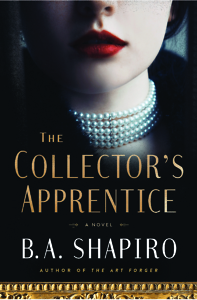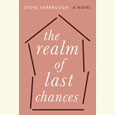Mastering the Arts
B.A. Shapiro’s The Collector’s Apprentice pays homage to both modern painting and the ancient craft of the hustle
Two kinds of art are featured in B.A. Shapiro’s latest novel, The Collector’s Apprentice. Paulien Mertens, a Belgian heiress and devotee of Post-Impressionism, studies painting at the Slade School in London during the early 1920s. When Paulien’s dashing fiancé, George Everard, turns out to be a mountebank playing a long game, she learns that becoming a successful con artist requires the same commitment and skill as becoming the next Cézanne or Matisse. And if Paulien wants to achieve the rarefied life she’s dreamt of—to create a collection of modern art that changes the public’s notion of beauty—she too will need to practice the lower arts of deception and subterfuge.

Shapiro packs her novel with intrigues and mysteries that play out over a decade. Paulien begins her story in 1928, as she is standing trial for the murder of her employer, the American art collector Edwin Bradley. The action then jumps back to 1922 as Paulien, vilified for her association with Everard, flees to Paris and changes her name to Vivienne Gregsby. Determined to rehabilitate her family’s honor and avenge herself on Everard, Vivienne becomes a translator (and much more) for Bradley, who is using his fortune to amass a collection of avant garde art. With Vivienne’s assistance, he plans to open a museum and a school for art appreciation in his hometown of Philadelphia.
When Bradley’s early exhibition of Post-Impressionists is derided by the Philadelphia press, he closes his collection to the public, allowing only a select few to admire the canvases by Seurat, Renoir, and others. Outwardly loyal to her employer’s wishes, Vivienne privately plots to open Bradley’s doors to the world. Further complications arise when Bradley, who is already married, declares his romantic attachment to her. Though she is tempted by the prospect of such an advantageous marriage, she feels more natural chemistry with Henri Matisse, one of Bradley’s favorite artists.
The novel’s title refers to Vivienne’s work with Bradley, but it carries a more sinister undertone as a reference to Vivienne’s apprenticeship as a swindler. Despite the rancor she feels for George Everard, she learns to apply his ruthless cunning in pursuit of her own goals. After Bradley, in one of his recurring tantrums, fires her, she regains her position by applying lessons she has gleaned from Everard. “What was is that led to George’s success?” Vivienne thinks. “He paid close attention to detail, didn’t skimp on what was necessary for the setup, and had the patience of a beast stalking its prey.”
The pleasures of The Collector’s Apprentice include Shapiro’s depiction of the time period, the romantic Lost Generation years when Thornton Wilder and Ernest Hemingway drank Pernod in Gertrude Stein’s atelier and connoisseurs debated the Matisse-Picasso rivalry at Les Deux Magots. Shapiro makes free use of historical figures, not simply as cameos (Scott and Zelda loud and drunk at a party!) but as crucial elements in the story. She credits The Autobiography of Alice B. Toklas as her inspiration for the novel’s ambience, so it’s unsurprising to watch Stein come alive here as a voice of saucy wisdom.
 Readers will also be charmed by the famous artists Shapiro also brings to life, an approach she used to great effect in The Muralist (2015), which featured abstract expressionists (Pollock, de Kooning, Rothko) before their fame. In The Collector’s Apprentice Matisse takes center stage. Vivienne is starstruck from the moment she meets him. “When Matisse sees her, he smiles widely, and she feels his delight in the pit of her stomach,” Shapiro writes. “He looks more like a handsome professor than a painter: full beard and round glasses, intelligence and good cheer writ large across his face.”
Readers will also be charmed by the famous artists Shapiro also brings to life, an approach she used to great effect in The Muralist (2015), which featured abstract expressionists (Pollock, de Kooning, Rothko) before their fame. In The Collector’s Apprentice Matisse takes center stage. Vivienne is starstruck from the moment she meets him. “When Matisse sees her, he smiles widely, and she feels his delight in the pit of her stomach,” Shapiro writes. “He looks more like a handsome professor than a painter: full beard and round glasses, intelligence and good cheer writ large across his face.”
Shapiro’s novel about the world of art makes nimble use of ekphrasis, poetic descriptions of artworks that enable readers not simply to visualize them but to view them through Vivienne’s eyes. When Vivienne sees Cézanne’s Leda and the Swan at a Paris gallery, for example, “her heart slips. Those succulent blues against the yellow-orange of both the swan’s beak and Leda’s ringlets, the sexuality in every twist of their bodies, in every swirl of the fabric, the desire in the swan’s grasp of Leda’s wrist.” Despite the disappointments she has endured, Vivienne feels a fresh ardor in the presence of visionary art.
The Collector’s Apprentice follows a wide-ranging plot but remains at its core a coming-of-age tale, the sentimental education of a young woman who wants to find satisfaction in work, love, and home. Paulien Mertens, once an innocent princess, learns the peril of kissing frogs; as Vivienne Gregsby, she does not wait around for a prince to save her.

Sean Kinch grew up in Austin and attended Stanford. He earned a Ph.D. from the University of Texas. He now teaches English at Montgomery Bell Academy in Nashville.


